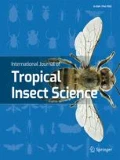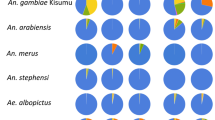Abstract
Rapid spread of vector borne diseases, especially through mosquitoes is in alarming rise worldwide. Among mosquitoes, Aedes aegypti is a major vector transmitting arboviruses such as dengue and zika to human population. The ineffectiveness of control measures against these arboviruses has necessitated alternate strategies to curb disease transmission. Recent studies show that symbiotic bacteria from insects hinder pathogen transmission by altering vector competence. Therefore, analyzing the bacterial communities of mosquitoes is essential to identify potential bacteria that play a critical role in vector competence. Salivary gland, a key organ in viral transmission however, is minimally explored towards their microbiota. In this study, we have screened 28 bacterial isolates from salivary glands of non-blood fed (NBF) and blood fed (BF) female Ae. aegypti, collected from the field population of Coimbatore, India. Among them, 11 bacterial species from distinct genera belonging to three major phyla; Proteobacteria, Firmicutes and Actinobacteria were identified through 16S rRNA gene sequencing. Interestingly, the differences in bacterial species associated with salivary glands were clearly discernible. This suggests that the dynamics of bacterial population after blood feeding is not restricted to the mosquito gut, but envisioned in the salivary glands as well. Overall, the results shed more light into the understating on salivary glands microbiota of dreadful vector Ae. aegypti.



Similar content being viewed by others
Data availability
Not Applicable.
References
Apte-Deshpande A, Paingankar M, Gokhale MD, Deobagkar DN (2012) Serratia odorifera a midgut inhabitant of Aedes aegypti mosquito enhances its susceptibility to dengue-2 Virus. PLoS One 7:e40401
Ateyyat MH, Shatnawi M, Al-Mazra’awi M (2010) Isolation and identification of culturable forms of bacteria from the sweet potato wzhitefly Bemesia tabaci Genn. (Homoptera: Aleyrodidae) in Jordan. Turk J Agric For 34:225–234
Bhatt S, Gething PW, Brady OJ, Messina JP, Farlow AW, Moyes CL, Drake JM, Brownstein JS, Hoen AG, Sankoh O, Myers MF, George DB, Jaenisch T, Wint GR, Simmons CP, Scott TW, Farrar JJ, Hay SI (2013) The global distribution and burden of dengue. Nature 496:504–507
Bisi DC, Lampe DJ (2011) Secretion of anti-Plasmodium effector proteins from a natural Pantoea agglomerans isolate by using PelB and HlyA secretion signals. Appl Environ Microbiol 77:4669–4675
Carrington LB, Simmons CP (2014) Human to mosquito transmission of dengue viruses. Front Immunol 5:1–8
Chavshin AR, Oshaghi MA, Vatandoost H, Pourmand MR, Raeisi A, Enayati AA, Mardani N, Ghoorchian S (2012) Identification of bacterial microflora in the midgut of the larvae and adult of wild caught Anopheles stephensi: A step toward finding suitable paratransgenesis candidates. Acta Trop 121:129–134
Coon KL, Vogel KJ, Brown MR, Strand MR (2014) Mosquitoes rely on their gut microbiota for development. Mol Eco 23:2727–2739
Dada N, Jumas-Bilak E, Manguin S, Seidu R, Stenström T, Overgaard HJ (2014) Comparative assessment of the bacterial communities associated with Aedes aegypti larvae and water from domestic water storage containers. Par Vec 7:1–12
Martínez De Salazar P, Suy A, Sánchez-Montalvá A, Rodo C, Salvador F, Molina I (2016) Zika Fever. Enferm Infec Microbiol Clin 34:247–252
Dennison NJ, Jupatanakul N, Dimopoulos G (2014) The mosquito microbiota influences vector competence for human pathogens. Curr Opin Insect Sci 1:6–13
Dhar R, Kumar N (2003) Role of mosquito salivary glands. Curr Sci 85:1308–1313
Engel P, Moran NA (2013) The gut microbiota of insects – diversity in structure and function. FEMS Microbiol Rev 37:699–735
Ferbiyanto A, Rusmana I, Raffiudin R (2015) Characterization and identification of cellulolytic bacteria from gut of worker Macrotermes gilvus. HAYATI J of Biosci 22:197–200
Gaio AO, Gusmão DS, Santos AV, Berbert-Molina MA, Pimenta PF, Lemos FJ (2011) Contribution of midgut bacteria to blood digestion and egg production in Aedes aegypti (diptera: culicidae) (L.). Par Vec 4:1–10
Gusmão DS, Santos AV, Marini DC Jr, Berbert-Molina MB, Lemos MAFJA (2010) Culture-dependent and culture-independent characterization of microorganisms associated with Aedes aegypti (Diptera: Culicidae) (L.) and dynamics of bacterial colonization in the midgut. Acta Trop 115:275–281
Guzman GM, Halstead SB, Artsob H, Buchy P, Farrar J, Gubler DJ, Hunsperger E, Kroeger A, Margolis HS, Martínez E, Nathan MB, Pelegrin JL, Simmons C, Yoksan S, Peeling R (2010) Dengue: a continuing global threat. Nat Rev Micro 8:S7–S16
Helgason E, Økstad OA, Caugant DA, Johansen HA, Fouet A, Mock M, Hegna I, Kolstø AB (2000) Bacillus anthracis, Bacillus cereus, and Bacillus thuringiensis—one species on the basis of genetic evidence. Appl Environ Microbiol 66:2627–2630
James AA, Rossignol PA (1991) Mosquito salivary glandss: Parasitological and molecular aspects. Parasitol Today 7:267–271
Jayasudha R, Narendran V, Manikandan P, Prabagaran SR (2014) Identification of polybacterial communities in patients with postoperative, posttraumatic, and endogenous endophthalmitis through 16S rRNA gene libraries. Clinic Microbiol 52:1459–1466
Johnson KJ (2015) The impact of Wolbachia on virus infection in mosquitoes. Viruses 7:5705–5717
Kean J, Rainey SM, McFarlane M, Donald CL, Schnettler E, Kohl A, Pondeville E (2015) Fighting Arbovirus Transmission: Natural and engineered control of vector competence in Aedes Mosquitoes. Insects 6:236–278
Kraemer MUG, Sinka ME, Duda KA, Mylne A, Shearer FM et al (2015) The global distribution of the arbovirus vectors Aedes aegypti and Ae. albopictus. eLife 4:e08347
Kyle JL, Harris E (2008) Global Spread and Persistence of Dengue. Annu Rev Microbiol 62:71–92
Mathur G, Sanchez-Vargas I, Alvarez D, Olson KE, Marinotti O, James AA (2010) Transgene-mediated suppression of dengue viruses in the salivary glandss of the yellow fever mosquito, Aedes aegypti. Ins Mol Biol 19:753–763
Miller RA, Beno SM, Kent DJ, Carroll LM, Martin NH, Boor KJ, Kovac J (2016) Bacillus wiedmannii sp. nov., a psychrotolerant and cytotoxic Bacillus cereus group species isolated from dairy foods and dairy environments. Int J Syst Evol Microbiol 66:4744–4753
Minard G, Mavingui P, Moro CV (2013) Diversity and function of bacterial microbiota in the mosquito holobiont. Par Vec 6:1–12
Molina-Henao EH, Graffe MY, Elsa P, Serrato IM, Correa A, Romero LV, … Ocampo CB (2020) Culturable microbial composition in the midgut of Aedes aegypti strains with different susceptibility to dengue-2 virus infection. Symbiosis 80(1):85–93
Moro CV, Tran FH, Raharimalala FN, Ravelonandro P, Mavingui P (2013) Diversity of culturable bacteria including Pantoea in wild mosquito Aedes albopictus. BMC Microbiol 13:1–11
Mourya DT, Pidiyar V, Patole M, Gokhale MD, Shouche Y (2002) Effect of Midgut bacterial flora of Aedes egypti on the susceptibility of mosquitoes to dengue viruses. Deng Bullet 26:190–194
Mousson L, Zouache K, Arias-Goeta C, Raquin V, Mavingui P, Failloux A (2012) The native Wolbachia symbionts limit transmission of dengue virus in Aedes albopictus. PLoS Negl Trop Dis 6:e1989
Ngo CT, Romano-Bertrand S, Manguin S, Jumas-Bilak E (2016) Diversity of the bacterial microbiota of Anopheles mosquitoes from Binh Phuoc Province, Vietnam. Fron Microbiol 7:1–11
Ramirez JL, Short SM, Bahia AC, Saraiva RG, Dong Y, Kang S, Tripathi A, Mlambo G, Dimopoulos G (2014) Chromobacterium CspP reduces malaria and dengue infection in vector mosquitoes and has entomopathogenic and In Vitro anti-pathogen activities. PLoS Pathog 10:e1004398
Rani A, Sharma A, Rajagopal R, Adak T, Bhatnagar RK (2009) Bacterial diversity analysis of larvae and adult midgut microflora using culture-dependent and culture-independent methods in lab-reared and field-collected Anopheles stephensi-an Asian malarial vector. BMC Microbiol 9:1–22
Rebijith KB, Asokan R, Kumar NKK, Srikumar KK, Ramamurthy VV, Bhat PS (2012) DNA barcoding and development of species-specific markers for the identification of tea mosquito bugs (Miridae: Heteroptera) in India. Environ Entomol 41:1239–1245
Sambrook J, Fritsch EF, Maniatis T (1989) Molecular cloning. Cold Spring Harbor Laboratory, Cold Spring Harbor
Scolari F, Casiraghi M, Bonizzoni M (2019) Aedes spp. and their microbiota: a review. Fronti Microbiol 10:2036
Sharma P, Sharma S, Maurya RK, De TD, Thomas T, Lata S, Singh N, Pandey KS, Valecha N, Dixit R (2014) Salivary glandss harbor more diverse microbial communities than gut in Anopheles culicifacies. Par Vec 7:1–7
Sinkins SP (2004) Wolbachia and cytoplasmic incompatibility in mosquitoes. Insect Biochem Mol Biol 34:723–729
Smith TW, Walker ED, Kaufman MG (1998) Bacterial density and survey of cultivable heterotrophs in the surface water of a freshwater marsh habitat of Anopheles quadrimaculatus larvae (Diptera: Culicidae). J Am Mosq Cont Assoc 14:72–77
Tchioffo MT, Boissière A, Abate L, Nsango SE, Bayibéki AN, Awono-Ambéné PH, Christen R, Gimonneau G, Morlais I (2016) Dynamics of bacterial community composition in the malaria mosquito’s epithelia. Fron Micrbiol 6:1–9
Weaver SC, Reisen WK (2010) Present and Future Arboviral Threats. Antivir Res 85:1–36
Werren JH, Baldo L, Clark ME (2008) Wolbachia: master manipulators of invertebrate biology. Nat Rev Microbiol 6:741–751
Wilke ABB, Marrelli MT (2015) Paratransgenesis: a promising new strategy for mosquito vector control. Par Vec 8:1–9
Yadav KK, Bora A, Datta S, Chandel K, Gogoi HK, Prasad GBKS, Veer V (2015) Molecular characterization of midgut microbiota of Aedes albopictus and Aedes aegypti from Arunachal Pradesh, India. Par Vec 8:1–8
Yadav KK, Datta S, Naglot A, Bora A, Hmuaka V, Bhagyawant S, Gogoi HK, Veer V, Raju PS (2016) Diversity of cultivable midgut microbiota at different stages of the Asian tiger mosquito, Aedes albopictus from Tezpur, India. PLoS One 11:1–16
Yu J, Guan X, Liu C, Xiang W, Yu Z, Liu X, Wang G (2016) Lysinibacillus endophyticus sp. nov., an indole-3-acetic acid producing endophytic bacterium isolated from corn root (Zea mays cv. Xinken-5). Ant Van Leeu 109:1337–1344
Acknowledgements
We acknowledge the University Grants Commission (Govt. of India), New Delhi for the grant provided to establish infrastructure in the Department of Biotechnology, Bharathiar University, Coimbatore vide F3-20/2013 (SAP-II). S. Balaji would like to acknowledge for the UGC-BSR fellowship F.4 − 1/2006(BSR)/7–25/2007(BSR). We thank Centre for Research in Medical Entomology, Indian Council of Medical Research, Field station, Coimbatore for their help in mosquito identification. We also acknowledge Dr. S. Mohankumar, Department of Plant Biotechnology, Tamil Nadu Agricultural University, for provided microscopic facility for dissection of mosquito tissues.
Funding
This work was not supported by any external or internal funding agencies.
Author information
Authors and Affiliations
Corresponding author
Ethics declarations
Conflicts of interest/Competing interests
The authors declare that they have no conflict of interest.
Ethics approval
Not Applicable.
Consent to participate
Not Applicable.
Consent for publication
Not Applicable.
Code availability
Not Applicable.
Additional information
Publisher’s note
Springer Nature remains neutral with regard to jurisdictional claims in published maps and institutional affiliations.
Rights and permissions
About this article
Cite this article
Balaji, S., Shekaran, S.G. & Prabagaran, S.R. Cultivable bacterial communities associated with the salivary gland of Aedes aegypti. Int J Trop Insect Sci 41, 1203–1211 (2021). https://doi.org/10.1007/s42690-020-00310-9
Received:
Accepted:
Published:
Issue Date:
DOI: https://doi.org/10.1007/s42690-020-00310-9




